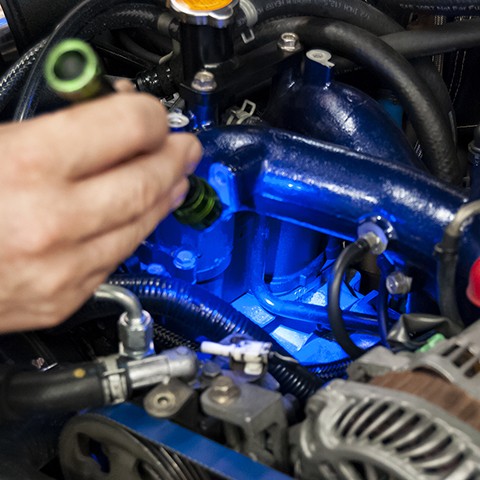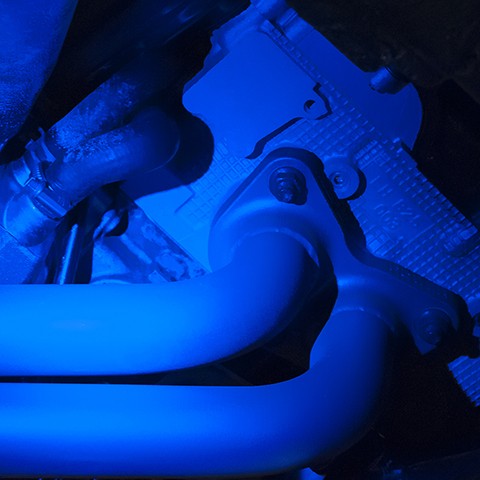It’s been a while, but we’re back with another update to the Subaru Project! In Part 5, Kyle installed our pre-production Performance head gaskets (Part # 26670) and was putting the car through its paces.
Kyle told us he put about 3150 miles on the car in 2017. About 1250 of those miles were part of a multi-state journey to and from Wicked Big Meet 2017, a Subaru enthusiast festival in Connecticut. Kyle told us the car saw everything from highway cruising to completely stopped traffic jams, all in 90+ degree weather in both rain and sunshine. An additional 775 miles at the end of 2017 were spent driving to and from the home of Fel-Pro, Skokie, IL to visit John Gurnig at the Fel-Pro Field Test Garage! At the Field Test Garage, John validated that the gaskets were performing exactly as they should.
Having left Cleveland at 5am, Kyle picked up an hour with the time zone change and arrived in Chicago right around 11. It was raining, and traffic was heavy (when isn’t it?) but he made his way to Skokie. He said the drive was easy and the car was completely manageable both on the highway and in Chicago’s traffic. The Subaru parked right outside the Field Test Garage a little after noon, and after signing in and meeting with John, they were off to lunch to discuss how John would be validating the gaskets.

Reserved for Field Test Vehicles? This looks like a good place to park…

Taking a break at a rest area along the Ohio Turnpike after leaving Cleveland at 5am.

Arriving in Chicago right around 11am. Not far left to go now, just head north to Skokie!

And there it is: The Fel-Pro Field Test Garage. This is where the magic happens!

Ready to go! But first, let’s grab lunch.
As part of the gasket validation process, John installs and inspects gaskets on over 100 test vehicles every year on a rotating, time-based inspection schedule. Most Field Test Vehicles belong to employees but some, such as Kyle’s Subaru, are from outside sources as well. The tests performed depend on the type of gaskets installed and what is being validated. In this case, the validation comes in the form of long-term, real world use. There were no indications of leaks, but we have to check in order to mark these gaskets validated!
The first check John performed was a complete visual inspection. He started at the top of the engine and inspected the head gasket joints where the heads meet the block. A mirror and flashlight allowed him to check on some more difficult to see areas. With no signs of leaks during the standard visual inspection, he broke out the UV light and checked again.

John Gurnig inspects the head gasket joints on top of the engine for any signs of leaks.

Clean and Dry! One of John’s favorite phrases!

John uses a UV light to double-check the head gasket joints on top of the engine.

Still looking good! No glowing coolant puddles or deposits!
He continued by hoisting the car and checking the underside, back side and all other exposed areas, confirming there were no leaks.

John also inspects both head gasket joints on the bottom of the engine.

No sign of leaks! Not that we expected any.

Close up, Clean and Dry. This engine is sealed right!

John also inspected the head gasket joints on the back side of the engine. Again, no leaks were found.

One last round of UV inspection, and we are leak-free!
While the main goal was to validate the head gaskets, John also checked the valve cover gaskets, intake gaskets, and all other areas for leaks, as Fel-Pro gaskets were used in these areas as well. Kyle told us he is very meticulous about keeping an eye on fluid levels, and that no oil or coolant was lost at any point, so we know there are no internal leaks. The only thing left to do was validate the combustion seal.
To validate the combustion seal, a nitrogen sealability test was performed. This test can be thought of as a hopped-up version of a cylinder leakdown test. When performing a standard cylinder leakdown test, the cylinder is pressurized with shop air to about 100 psi with the piston at top dead center and all valves closed. Nitrogen sealability testing is done the same way, but the cylinder is pressurized with nitrogen at about 1000 psi! While this is still lower than the normal operating maximum cylinder pressure, it’s much closer than 100 psi. If any bubbles appear in the cooling system, they would indicate nitrogen is leaking past the combustion seal and into the cooling system. There were no bubbles to be found, indicating a solid combustion seal at all cylinders.

John fills the cylinder with compressed nitrogen.

Preparing to perform a nitrogen sealability test, one of the 14 steps of our validation process.

Compressed nitrogen is used to pressurize the cylinders, similar to a cylinder leakdown test.

However, nitrogen sealability testing happens at about 10x higher pressure than a leakdown test with shop air – 1000 psi!

No bubbles in the cooling system with the cylinders pressurized means no combustion leaks!
Happy with the results, John marked down a successful field validation of the Subaru Performance head gaskets, part number 26670. They put the car back together, and Kyle took it home to Cleveland. He will be continuing on into the 2018 season on the same gaskets, with some plans to make even more power through the use of E85 fuel and a few other surprises. Stay tuned for Part 7 when we wrap up the Subaru Project – See ya next time!

100% leak-free, 100% sealed and 100% FTG Validated.
The 26670 gaskets are available from your Fel-Pro distributors now, and a version with holes to accommodate head studs up to 14mm in diameter (Part # 26742) is coming soon. Fel-Pro is looking for professional engine builders and Subaru specialty shops to check out these gaskets and provide feedback. If you would like to talk with us about these gaskets, send an email to Support@FelPro-Only.com with the title “Subaru Performance” and we will reach out to your shop/business for more information.
Autres pièces pour votre véhicule
Fel-ProMD propose une grande variété de pièces auto pour tous vos besoins automobiles.
Découvrez-les maintenant!